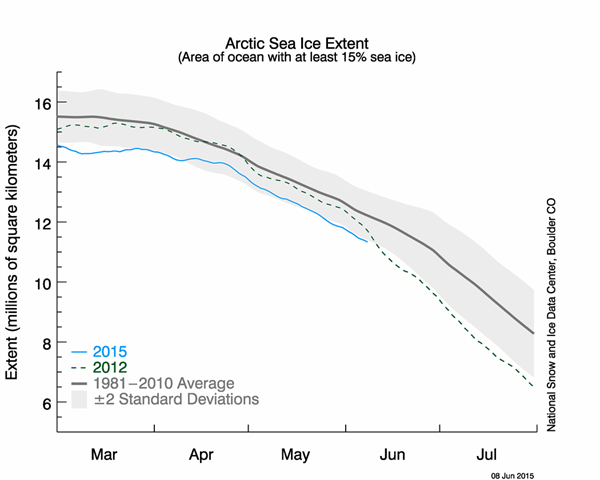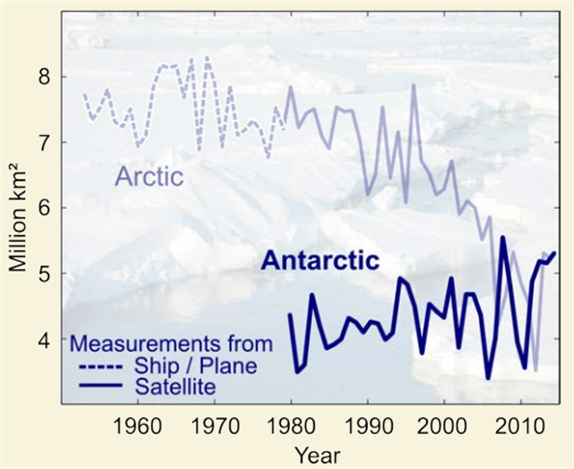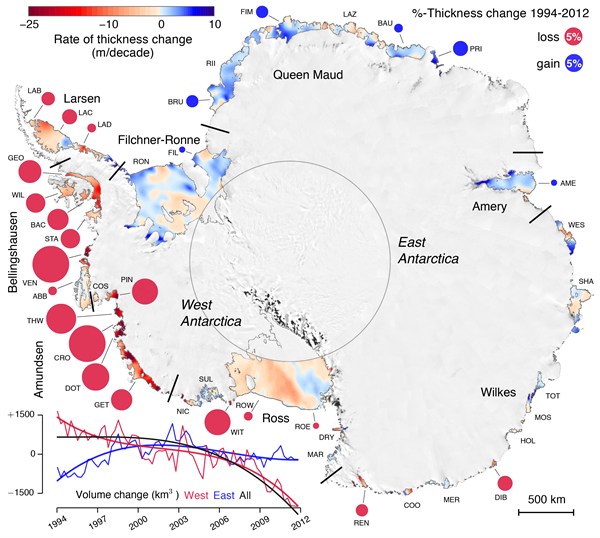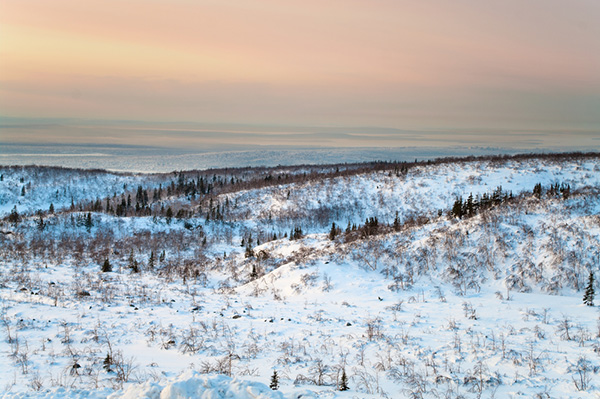Irreversible loss of world's ice cover should spur leaders into action, say scientists
Posted on 29 June 2015 by Guest Author
This is a re-post from Carbon Brief by Roz Pidcock
We need only look to the world's ice cover to see the urgency with which emissions need to come down, scientists told delegates at this week's climate talks in Bonn, Germany.
At a press conference today, US and German scientists updated negotiators and journalists with the latest science on the state of Arctic sea ice, the Antarctic continent and thawing permafrost.
New observations gathered since the Intergovernmental Panel on Climate Change (IPCC) report show the cryosphere in serious and irreversible decline, they warned.
Pam Pearson, director of the International Cryosphere Climate Initiative, the network of policy experts and researchers holding the event, told the audience:
"This is not like air pollution or water pollution, where if you clean it up it will go back to the way it was before."
Sea ice in decline
Arctic sea ice has been retreating rapidly in recent years as a result of greenhouse gases building up in the atmosphere, explained Dr Dirk Notz, sea ice expert at the Max Planck Institute in Germany. The biggest losses are happening in summer, he said:
"Over the past 10 years or so, we've roughly seen a 50% loss of Arctic sea ice area. So, the ice in the Arctic is currently retreating very, very rapidly."
In March, Arctic sea ice reached its lowest maximum extent in the satellite record. Last week, the US National Snow and Ice Data Centre confirmed Arctic sea ice extent for May was the third lowest on record.
Arctic sea ice extent for 2015 compared to the 1981-2010 long term average. Source: NSIDC
Antarctic sea ice has been at record high levels in 2015 but this should be viewed in perspective with what's happening at the other end of the planet, Notz said:
"There is a slight increase, but it's nothing compared to the very, very rapid loss that we've seen in the Arctic."
Scientists' current understanding is that temperature changes as a result of greenhouse gases are causing winds to blow stronger offshore in the Southern Ocean that surrounds Antarctica, driving the sea ice outwards. Notz said:
"Both in the Arctic and the Antarctic, the changes we are seeing in the sea ice are very clearly driven predominantly by human activities."

A slide from Dr Dirk Notz's presentation, putting Antartcic sea ice gain in perspective with the rate of Arctic sea ice loss. Source: ICCI press conference, Bonn June 2015
Model simulations suggest sea ice could be gone from the Arctic in summer by mid-century. But if we stop emitting greenhouse gases, the chances of losing sea ice diminish quickly, he said:
"Only a very strong and rapid reduction in carbon dioxide might allow for the survival of Arctic summer sea ice beyond this century."
Ice sheets at risk
Turning from sea ice to land ice, a few regions of West Antarctica have grabbed scientists' attention in the past year, explained Prof Ricarda Winkelmann from the Potsdam Institute for Climate Impact Research. Each has the potential to destabilise, raising global sea levels.
The Amundsen Basin in West Antarctica, which houses the Pine Island and Thwaites glaciers, is one of these "hotspots." Winkelmann explains:
"It has been shown in a number of studies last year that [the region] has tipped, meaning that it has crossed that threshold and is now undergoing irreversible change."
Once the glaciers in this region drain into the ocean, the volume of water will raise global sea levels by one metre. The question is how fast that will happen, said Winkelmann.
"We've known that this kind of mechanism exists for a long time, it was first proposed in the 1970s. But the observation that something like this is actually happening right now - that's a new one."
Map shows changes in Antarctic ice shelves from 1994 to 2012. Shading of ice shelves shows rate of thickness change (in metres per decade), from thinning (red) to thickening (blue). Dots show percentage of thickness lost (red) or gained (blue). Source: Paolo et al. (2015)
A second region that's been discussed a lot this year is the Antarctic Peninsula. Warm water is reaching the ice shelves and thinning them from the bottom up, recent research shows.
The scientists are watching the Totten glacier in East Antarctica closely, as the same process of irreversible collapse could be at work there too, they say.
Totten is currently thinning faster than any other glacier in East Antarctica and, if it melts, could raise sea levels by 3.5m - more than the whole of the West Antarctic ice sheet put together.
Permafrost thaw
Carbon has been accumulating in permafrost for many thousands of years, but it is starting to be released as warmer temperatures are causing the once-permanently frozen ground to thaw.
Scientists currently estimate there is 1,500bn tonnes of carbon currently locked away in permafrost. That's twice as much as in the atmosphere, explained Dr. Susan Natali, an expert in permafrost feedbacks on climate from the Woods Hole Research Center in the US.
If even a small amount of that carbon escapes to the atmosphere, it could lead to a significant increase in global greenhouse gas emissions, said Natali.
Polar night in mountains in northern tundra in Russia. Source: Kekyalyaynen, Shutterstock.
If emissions stay very high, scientists expect to see a 70% loss in permafrost worldwide by 2100. This could be reduced to 30% if global temperatures are limited to 2C above pre-industrial levels, Natali explained.
How much carbon will find its way to the atmosphere is a complex question. But current estimates are for 130-160bn tonnes of carbon to be released by 2100. That's on par with current rate of emissions from the whole of the United States, the world's second largest emitter.
The actions that we take now in terms of our fossil fuel emissions will have a significant impact on how much permafrost is lost and, in turn, how much carbon is released, said Natali:
"We know that permafrost emissions will be substantial and irreversible on a human-relevant timeframe and these emissions of greenhouse gases from permafrost need to be accounted for if we want to meet our global emissions targets."
A matter of urgency
This new science isn't feeding into international climate policy as it should be, said Pearson:
"What the IPCC scientists see is a lack of understanding of the urgency of slowing down these processes and the fact that they are irreversible … I think that is the most important aspect [of the science] that still hasn't made it into the negotiations."
Notz urged policymakers to view climate change as a current, not a future, challenge. He said:
"So far, these negotiations have been driven by the idea that this is something that will happen at some point. But if you really look at the developments that have happened over the past two, three or four years, especially in the cryosphere … [they] will have consequences for the next centuries ... We're not speaking about the future here, we're speaking about ongoing changes."
In light of the wealth of new science, Pearson said she would like to see ambitions raised ahead of a global climate agreement in Paris later this year. She said:
"It's clear that given these challenges, the current INDC's [Intended Nationally-Determined Contributions] are not sufficient."
As well as greater ambition, Pearson said she wants to see the flexibility in the final Paris text to enable countries to raise their targets without going through a lengthy negotiation process.
Changes are taking place faster in the cryosphere than anywhere else, making it an ideal lens through which to view climate change negotiations, Pearson concluded. The processes taking place cannot be reversed and while they won't happen while these policymakers are in office, limiting the damage for future generations is a critical part of leadership, she said.
UPDATE: The article was updated on June 10th once Dr Dirk Notz's slides became available online. The figure from his presentation compares changes in Arctic and Antarctic sea ice.































 Arguments
Arguments
































Assuming the obvious, that global warming will cause direct melting of polar ice caps, let's look at the RATE of sea level increase since the mid-1800s. Google the data with this search: Battery NOAA Sea Level. That give a long-tern look at data. The chart will show a strict linear trend of increase, not the least bit influenced by the world population increase from 1 billion to 7 billion since the beginning of that data measurement. Given that burning of hydrocarbons MUST have increased at least an order of magnitude in that time, the data completely mitigate against any conclusion that there has been influence of man on sea level rise and thus global warming.
[TD] Your comment is off topic for this thread. Please place further comments on this topic on the thread "How Much Is Sea Level Rising?" Please actually read that post before you comment, instead of making a comment that clearly is refuted in the post. For example, in that post note the greater than linear increase in sea level when measured away from plate boundaries and areas of isostatic rebound, and when measured globally instead of at one location. (Shocking to some is the fact that Manhattan is not the entirety of the world.) Also note that your crude speculation about CO2 rise is unnecessary, because it has been measured.
There is an interesting page, Paul Ward's "Cool Antarctica" that makes an interesting read related to this:
http://www.coolantarctica.com/Antarctica%20fact%20file/science/global_warming.php
Under the discussion of the West Antarctic Ice Sheet [and its apparent slow collapse] is the statement:
"The end result of this is the possibility that we have already been committed to a rise in global sea levels by 3m or more over the coming centuries."
[JH] Link activated.
Suggested suplemental reading:
Melting Arctic sea ice could be disrupting the oceans’ circulation—with major consequences by Chelsea Harvey, Energy & Environment, Washington Post, June 29, 2015